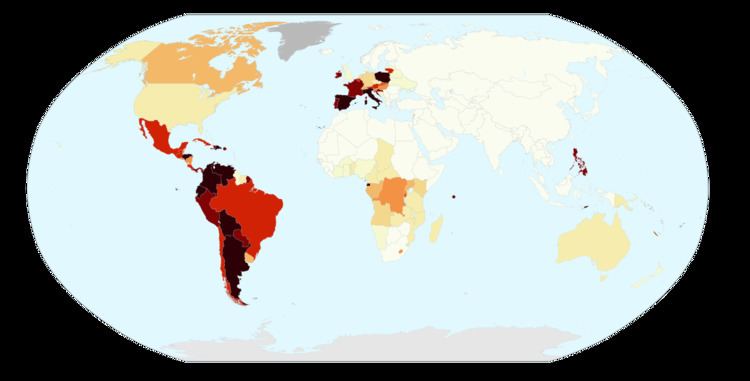 | ||
The Catholic Church in Mexico is part of the worldwide Catholic Church, under the spiritual leadership of the Pope, his Curia in Rome and the national Mexican Episcopal Conference. The history of Roman Catholicism in Mexico dates from the period of the Spanish conquest (1519–21) and has continued as an institution in Mexico into the twenty-first century. In the late 20th century, Eastern Catholic jurisdictions were established in Mexico.
Contents
History
The history of the Roman Catholic Church in Mexico can be divided into distinct periods, the basic division being between colonial Mexico, known as New Spain and the national period, from Mexican independence in 1821 until the current era.
The era of the military conquest in the early sixteenth century saw the Church's huge effort to evangelize the indigenous population of Mexico in what is termed "the spiritual conquest." As the Spanish Empire expanded into new territories, the incorporation of the indigenous population was a priority for the crown. The growth of the Spanish and mixed-race urban population of Mexico prompted the establishment of the episcopal hierarchy, under the patronage of the monarch and the creation of dioceses in Mexico.
In the national period, following independence in early nineteenth century, Mexico established a legal framework that continued the privileged status of the Catholic Church as the sole religion. The liberal Reforma of the late 1850s sparked an extended period of violent conflict between the conservative supporters of the old order and liberals who sought to displace and diminish the power of the Church. The Mexican Revolution was won largely anticlerical Constitutionalists and the Church's role in Mexico was restricted constitutionally.
After a period of violent open conflict over religious matters, Church-State relations returned to a modus vivendi while the anticlerical constitutional framework remained in place. Expansion of Catholic participation in the establishment of religious educational institutions and the creation of a conservative political party, the National Action Party with no direct ties to the Church was an important characteristic of the late twentieth century. A new constitutional framework was created in 1992, which lifted many but not all restrictions on religious freedom and the Catholic Church in Mexico.
Mexican National Catholic Church
Distinct from the Catholic Church in Mexico, the Mexican National Church emerged during the Mexican Revolution, when antagonisms against the Church of Rome were inflamed on account of its connection to historic Spanish colonialism. After several attempts at establishing a national church, the Mexican Catholic Apostolic Church was founded in 1925 by José Joaquín Pérez Budar with the support of the Regional Confederation of Mexican Workers and the Mexican President Plutarco Elías Calles. It quickly incorporated Mexican communities in Texas into itself.
The National Church continued as an “Old Catholic” community until Father José Cortes y Olmos was appointed its bishop in 1961. Over time he and his clergy determined that the ecclesiology of the Old Catholics did not satisfy the Marks of the Church and took on the name Iglesia Ortodoxa Católica en Méxicao (Orthodox Catholic Church in Mexico) for their community.
In 1965 Bishop Cortes contacted Dmitri Royster, then the rector of Saint Seraphim Church in Dallas, Texas. Royster played an important role as an Orthodox missionary to Mexico and liturgical translator. After Father Dimitri’s consecration to the episcopacy in 1969 and the granting of autocephaly the following year, Bishop Dmitri presented the case of the Orthodox Church in Mexico to the hierarchy of the Orthodox Church in America. As a result of numerous exchanges, the Holy Synod sent Royster to conduct an official investigation on the state of the Church in Mexico and to produce a report, which would be studied by the OCA Department of Canonical Affairs. Upon review of Royster's report, the Department recommended that the Orthodox Church incorporate the Mexican communities.
In 1971, Cortes petitioned for the OCA to integrate his community. He and his fellow clergy were received at their Catholic ecclesiastical ranks, while an estimated ten to twenty thousand faithful were also received into the Orthodox faith.
Organization of the Church in Modern Mexico
The Catholic Church is the world's largest Christian church, and its largest religious grouping. The 2010 census reported that Mexico had some 101,456,786 Catholics among the population aged five and above, which equates to around 91% of the total population, making it the second largest Catholic country in the world after Brazil. The country is divided into 18 Ecclesiastical provinces, containing a total of 90 dioceses. There are 15,700 diocesan priests and 46,000 men and women in religious orders.
Pope Francis selected 15 new cardinals for the Church in January 2015, one of whom was for Mexico in the archdiocese of Morelia. Alberto Suárez Inda is Morelia's first cardinal. According to an Associated Press story, he "has helped mediate political conflicts and kidnappings in one of Mexico's most violence-plagued states."
Latin Church hierarchy
Mexico's ecclesiastical provinces were organized as follows, on 25 November 2006:
Eastern Catholic jurisdictions
There are also separate jurisdictions for specific Eastern particular churches within the Catholic Church in Mexico:[1]
